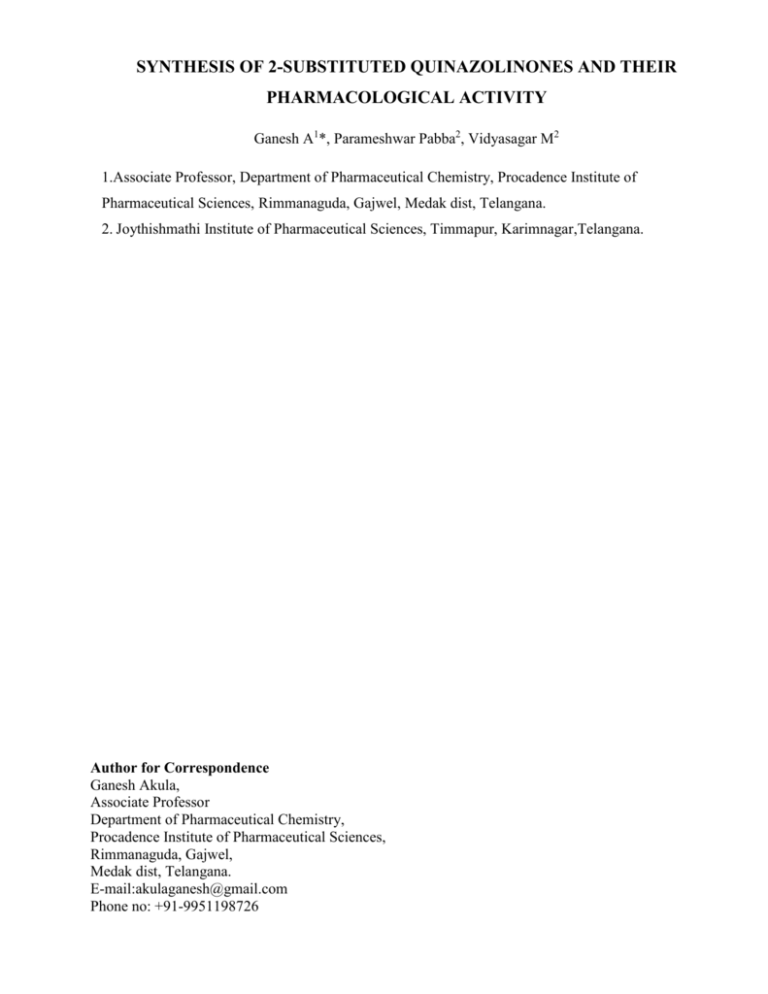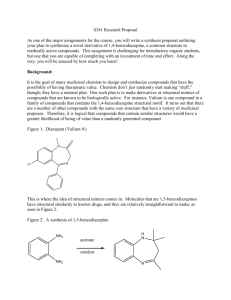conclusion - International Journal of Advances in Pharmaceutical
advertisement

SYNTHESIS OF 2-SUBSTITUTED QUINAZOLINONES AND THEIR PHARMACOLOGICAL ACTIVITY Ganesh A1*, Parameshwar Pabba2, Vidyasagar M2 1.Associate Professor, Department of Pharmaceutical Chemistry, Procadence Institute of Pharmaceutical Sciences, Rimmanaguda, Gajwel, Medak dist, Telangana. 2. Joythishmathi Institute of Pharmaceutical Sciences, Timmapur, Karimnagar,Telangana. Author for Correspondence Ganesh Akula, Associate Professor Department of Pharmaceutical Chemistry, Procadence Institute of Pharmaceutical Sciences, Rimmanaguda, Gajwel, Medak dist, Telangana. E-mail:akulaganesh@gmail.com Phone no: +91-9951198726 ABSTRACT: Quinazolinone is a heterocyclic chemical compound. There are two structural isomers, 2-quinazolinone and 4-quinazolinone, with the 4-isomer being the more common. Literature survey reveals that in recent years several quinazolinone derivatives have been synthesized and reported to possess varied biological and pharmacological properties. They are found to be useful as anti-bacterial, analgesic, antiinflammatory, anti-fungal, antimalarial, antihypertensive, CNS depressant, anticonvulsant, antihistaminic & local anaesthetic, anti-parkinsonism, antiviral and anticancer agents. In the present work, synthesis of 2substituted quinazolinone derivatives were carried out and these compounds were evaluated for their pharmacological activities especially anti-microbial activity. These compounds showed pharmacological activities in comparison with the standard. KEY WORDS: Quinazolinone, Anti-bacterial, Anti-fungal, Mannich reaction. INTRODUCTION: Quinazoline or 1,3-diazanaphthalene is a bicyclic compound made up of two fused six-membered simple aromatic rings consisting of pyrimidine system fused with benzene having broad spectrum of medicinal values. The many derivatives of quinazoline system known so far, keto-quinazolines also called as Quinazolinone, are the most important compounds. A number of alkaloids having quinazoline or quinazolinone moiety in their structure have been isolated from different plants. Quinazolinone derivatives were carried out according to scheme-1 and these compounds were evaluated for their pharmacological activities especially anti-microbial activity. These compounds showed pharmacological activities in comparison with the standard drugs. MATERIALS AND METHODS: Keeping in view an array of applications, it has been felt worthwhile to synthesize some new substituted quinazolinone derivatives as such reactions are not reported so for and also to screen for the anti-microbial activity. The synthesis of title compounds could be achieved by the Scheme-I. Collection of the chemicals: All chemicals are of analytical grade and are brought from Sd.fine Chem. Ltd. Experimental Procedure: Synthesis of 2-phenyl-4(3H)-Quinazolinone (compound a): Anthranilic acid (0.1mole) was dissolved in 100ml of methanolic potassium hydroxide. Then gradually added aryl amide (Benzamide, 0.1 moles).the contents were refluxed for 3 hours and were cooled to room temperature. The reaction mixture was filtered and washed with methanol and dried. The dried crude product was recrystallized from methanol to get the compound. Synthesis of 2-methyl-4(3H)-Quinazolinone (compound b):Anthranilic acid (0.1mole) was dissolved in 100ml of methanolic potassium hydroxide. Then gradually added alkyl amide (Acetamide, 0.1 moles).the contents were refluxed for 3 hours and were cooled to room temperature. The reaction mixture was filtered and washed with methanol and dried. The dried crude product was recrystallized from methanol to get the compound. Synthesis of 4(3H)-Quinazolinone (compound c): Anthranilic acid (0.1mole) was dissolved in 100ml of methanolic potassium hydroxide. Then gradually added alkyl amide (Formamide, 0.1 moles).the contents were refluxed for 3 hours and were cooled to room temperature. The reaction mixture was filtered and washed with methanol and dried. The dried crude product was recrystallized from methanol to get the compound. 3-[(dialkylamino)methyl]-2-substituted-4(3H)- Quinazolinone (compound a1-c1): 2-substituted4(3H)-Quinazolinone (0.01 mole) was taken in 5 ml of 95% ethyl alcohol and slurry was formed. To this gradually added 37% formaldehyde (0.02mole) and dialkyl amine (dimethyl amine, 0.01 moles). A clear solution was obtained. To this solution 30 ml of 95% ethyl alcohol was added and it was concentrated by evaporation on a hot plate until a semisolid was formed. This was purified by re crystallization with sufficient ethanol. Following compounds were prepared by using above procedure: 3-[(dimethyl amino) methyl]-2-phenyl-4(3H) - Quinazolinone (compound a1), 3-[(dimethyl amino) methyl]-2-methyl-4(3H)Quinazolinone (compound b1) and 3-[(dimethyl amino) methyl] -4(3H)- Quinazolinone (compound c1) 3-[(diarylamino)methyl]-2-substituted-4(3H)-Quinazolinones(compound a2- c2): 2-substituted-4(3H)Quinazolinone (0.01 mole) was taken in 5 ml of 95% ethyl alcohol and slurry was formed. To this gradually added 37% formaldehyde (0.02mole) and diaryl amine (diphenyl amine, 0.01 moles). A clear solution was obtained. To this solution 30 ml of 95% ethyl alcohol was added and it was concentrated by evaporation on a hot plate until a semisolid was formed. This was purified by re crystallization with sufficient ethanol. Following compounds were prepared by using above procedure: 3-[(diphenyl amino) methyl]-2-phenyl-4(3H) - Quinazolinone (compound a2), 3-[(diphenyl amino) methyl]-2-methyl-4(3H) Quinazolinone (compound b2) and 3-[(diphenyl amino) methyl] -4(3H) - Quinazolinone (compound c2) Compound a: R= C6H5, Compound a1: R1= R2= CH3, a2: R1= R2= C6H5 Compound b: R= CH3, Compound b1: R1= R2= CH3, b2: R1= R2= C6H5 Compound c: R= H, Compound c1: R1= R2= CH3, c2: R1= R2= C6H5 ANTI-MICROBIAL ACTIVITY: The synthesized compounds were tested against Bacillus Subtilis, Staphylococcus aureus, Escherichia coli, Aspergillus niger and Candida albicans. The glass Petri dishes were cleaned and sterilized. The nutrient agar media is mixed with sufficient amount of distilled water and sterilized. The media was allowed to solidify at room temperature. A sterile borer was used to prepare four cups of 8mm diameter in the agar media. A test solution of synthesized compounds was prepared at a concentration of 100µg/ml and 150 µg/ml with DMF. A solution of standard drug was prepared at the same concentration. Accurately measured (0.1 ml) solution of test and standard samples were added to cups with micropipette. All Petri dishes were incubated at 37±1ºC for 24 hrs. The solvent DMF was used as blank. The diameter of zone of inhibition was measured and recorded and shown in table 2. RESULTS AND DISCUSSION: Various New Derivatives of Quinazolinone were synthesized from Quinazolinone by Mannich reaction with 37% Formaldehyde, dimethyl amine/diphenyl amine and Ethanol. For the synthesis of Quinazolinone, Anthranilic acid was taken as a starting material, condensing with the amide and methanolic Potassium hydroxide. Physical characterization of the title compounds were given in the table-1. Antimicrobial Activity: Table-2 showing the data on antimicrobial activity of the compounds could reveal that all the six compounds could exhibit a moderate to potent activity, against both Gram positive and Gramnegative bacteria. Among the tested compounds, Compound a1, b1 & c1 was found to show an appreciable zone of inhibition against both Gram positive and Gram negative bacteria and its activity was found to be comparable to that of the standard drug Norfloxacin and Fluconazole. Table-1: Physical Characterization of the title compounds: S.No. Compound R R1 R2 M.P (0C) % Yield Molecular Formula Molecular weight 1. a -C6H5 - - 115 78.81 C14H10N2O 222 2. b -CH3 - - 110 77.00 C9H8N2O 160 3. c -H - - 105 78.76 C8H8N2O 146 4. a1 - -CH3 -CH3 103 77.00 C17H17N3O 279 5. a2 - -C6H5 -C6H5 105 75.00 C27H21N3O 403 6. b1 - -CH3 -CH3 138 79.00 C12H15N3O 217 7. b2 - -C6H5 -C6H5 150 77.00 C22H19N3O 341 8. c1 - -CH3 -CH3 154 92.27 C11H13N3O 203 9. c2 - -C6H5 -C6H5 102 78.00 C21H17N3O 327 Table-2: Anti-microbial activity of compounds a1 to c2 and Standard drugs Cup-plate diffusion method (Zone of inhibition in mm) Anti-bacterial activity Compound B.Subtilis S.Aureus Anti-fungal activity E.Coli A.Niger C.Albicans 100 150 100 150 100 150 100 150 100 150 µg/ µg/ µg/ µg/ µg/ µg/ µg/ µg/ µg/ µg/ ml ml ml ml ml ml ml ml ml ml Norfloxacin 22 25 22 25 22 25 - - - - Fluconazole - - - - - - 22 24 16 18 a1 21 22 18 20 17 19 18 20 14 16 a2 15 18 16 18 15 17 - 15 - 12 b1 18 20 17 19 20 21 15 19 10 12 b2 - 15 - 14 - - 10 11 10 12 c1 20 21 17 19 18 20 16 18 11 13 c2 14 16 15 17 13 15 11 15 09 12 CONCLUSION: In present investigation we have carried out the synthesis of some 2-substituted derivatives of quinazolinone by different substitutions like dimethylaminomethyl and diphenylaminomethyl, etc. Since the present new three (a1, b1, c1) Quinazolinone derivatives could exhibit potent Antimicrobial activity comparable with the standard employed, it is desirable to determine their toxicity to decide on whether to go for further screening or not. ACKNOWLEDGEMENT: I am very much thank full to the management of Procadence Institute of Pharmaceutical sciences for providing necessary facilities. I am also grateful to my colleagues and my friends for their kind help from time to time at each and every step of this work. REFERENCES: [1] Raj K.Bansal, Hetero Cyclic Chemistry, 4th edition, new age international publishers,(2005)527-528. [2] Chakravarthi and Chakravarthi, J.Indust.Chem. India, 24 (1952) 96. [3] Chatterjee and Majumdar, J.Am.Chem.Soc.75 (1953) 4365. [4] A .F. Cockerill and R.G.Harrison , in ‘The chemistry of Double Bonded Functional Groups’Ed.s.Patai , Interscience , New York , 1977, Suppl . A, Part I , 288. [5] K.B Campbell, H Sommers and B.K Campbell , J . Am Chem Soc., 1944, 66-82 [6] S.V. More , D.V. Dongerkhadekar, R.N.Chavan, W.N Jadhav , S.R.Bhusare and R.P.Pawar, J.Indian Chem . Soc , 2002,79, 768. [7] S.K Sridhar,M .Sarvanand,A.Ramesh Eur J med chem,2001,36,615 [8] Hassanzadeh et al, antibacterial, antifungal, cyto toxic evaluation of some new Quinazolinone derivatives, Research in pharmaceutical sciences, may 2012; 7(2):87-94. [9] G.A. Khodarhami et al, Synthesis and cyto toxic evaluation of some new 4(3H)-Quinazolinones and on HeLa cell line, Research in pharmaceutical sciences, may 2012; 7(2), 119-125. [10] Sarika Mehta et al, Synthesis and characterization of some quinazoline derivatives as potential antimicrobial agents under micro wave irradiation, bull.korean chem. Soc.2007, vol28, no12. [11] K. Manasa et al, Synthesis, antioxidant and anticancer activity of quinazoline derivatives, Current pharma research, CPR 1(2), 2011, 101- 105. [12] I. Philipova et al, Convenient synthesis of some 2-substituted- 4(3H)- Quinazolinone derivatives, J. Hetero cyclic chem., 43, 1057 (2006). [13] Safouane M. Hamdi et al, A micro wave assisted and hetero poly acids-catalysed cyclo condensation reaction for the synthesis of 4(3H)- Quinazolinones, Molecules 2008, 13, 779-789. [14] Kishor R. Desai et al, Niementowski reaction: micro wave induced and conventional synthesis of Quinazolinones and 3-methyl-1H-5-pyrazolones and their antimicrobial activity, ARKIVOC 2005 (xiii) 98-108. [15] CH. Rajveer et al, Synthesis of some 6- Bromo Quinazolinone derivatives for their pharmacological acivities, Indian journal of Pharma and bio sciences, vol.1, issue-3, jul-sep.2010. [16] Omar Abd El-Fattah M. Fathalla et al, Synthesis of some new Quinazoli-4-one derivatives and evaluation of their antimicrobial and anti-inflammatory effects, Acta poloniae Pharmaceutica- Drug research, 2008, vol.65, No.1, 11-20. [17] K. R. Desai et al, Synthesis and antimicrobial activity of newer Quinazolinones, E- journal of chemistry, may 2006,Vol-3, No.11, 97-102,. [18] Vijay K. Srivastava, I.P. Singh, Shrodha Singh M.B. Gupta and K. Shanker, Indian J.Pharmac. Sci. 48, (1986) 133.








